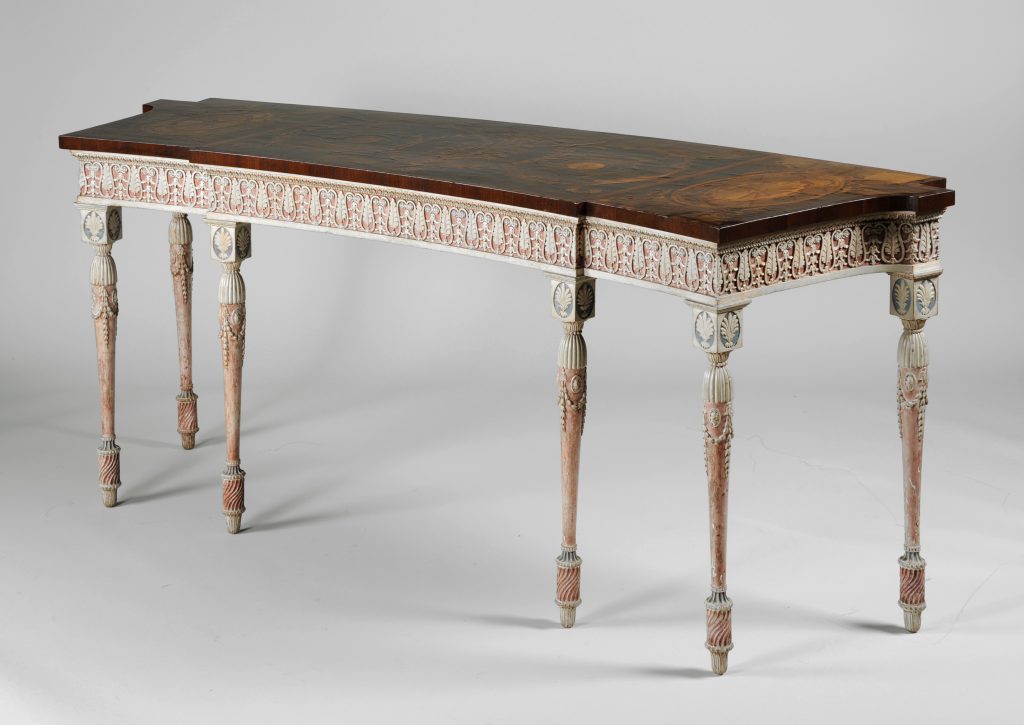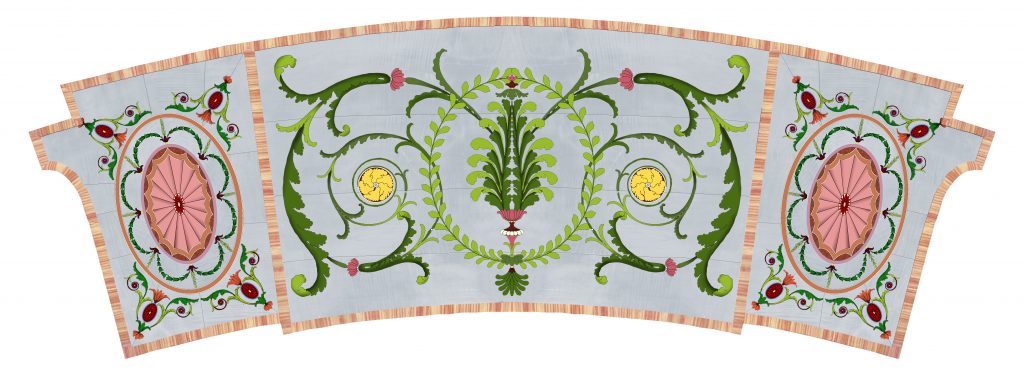
Ann Sumner and Adam Bowett in discussion about the Circular Dressing Room at the 42nd Annual Symposium of the Furniture History Society at Leeds Art Gallery on 14 April 2018. Photo: Rebecca Burton
In her second blog of this special Chippendale 300 series sponsored by Christie’s, Professor Ann Sumner shares her experience of the 42nd Annual Symposium of the Furniture History Society which was held on Saturday 14th April 2018 and interviews Dr Adam Bowett, Chairman of the Chippendale Society about the now lost Circular Dressing Room at Harewood House.
On 14th April in Leeds, at the City Art Gallery, over 130 Chippendale enthusiasts gathered to celebrate the life and work of Yorkshire’s famous cabinet maker, 300 years after his birth in nearby Otley. In the presence of Society Chairman Sir Nicholas Goodison and his wife Judith, herself an expert on Chippendale Junior, we were warmly welcomed by the Furniture History Society Chairman Christopher Rowell (National Trust Curator of Furniture) who encouraged everyone to visit the outstanding Leeds exhibition Thomas Chippendale: A Celebration of Craftsmanship and Design. Christopher praised the new catalogue by Adam Bowett and James Lomax, which has just been published as the most important contribution to Chippendale studies since Christopher Gilbert’s great work. The day was skilfully chaired by Lisa White, Editor of The Furniture History Society Journal with a distinguished group of furniture historians gathered from all over the country in attendance. The first paper Honouring a Local Hero: the Chippendale Society 1965 – 2018 was read for us by David Bower, as sadly James Lomax, co- curator of the exhibition, was unwell. This was followed by the first of three papers during the day focusing on the Harewood collections – an excellent study of the original furniture for the Circular Drawing Room at Harewood.
I was fortunate enough to catch up with Dr Adam Bowett, Chairman of the Chippendale Society and co-curator of the exhibition, later that day at the symposium, to ask him a few further questions about the Furniture for the Circular Dressing Room at Harewood.
Ann: The Circular Dressing Room was swept away in the 1840s and is now a room that we do not often mention at Harewood. Tell us about this fascinating circular space which was originally a dressing room – did its function change at all before the Victorians decided to dispense with it?
Adam: The Circular room was always something of a problem for Harewood’s architects because it was sandwiched between the main suites of State Rooms on the north and south fronts but didn’t easily link with either. Between 1758 and 1771 it was variously planned as a Gentleman’s Dressing Room, a small Dining Room, a Chapel and even a Billiards Room before ending up as a Ladies Dressing Room. It had one large window looking onto an interior court, facing east to make the best of the morning light.
Ann: Could you explain how you entered the room?
Adam: In its final form, the room acted as a dressing room to the State Bedchamber, accessible from the back of the bed alcove through two small closets. It was scarcely convenient.

Pier table made for the Circular Dressing Room at Harewood House, 1771 – 2. This now belongs to the Chippendale Society and is currently on loan to the Thomas Chippendale: A Celebration of Craftsmanship and Design at Leeds Museum, having been especially conserved for the display. Photo courtesy of The Chippendale Society.
Ann: You have made an in depth study of the Pier Table made for the Circular Dressing Room of 1772 which is usually on display at Temple Newsam and is now on loan from the Chippendale Society to the current exhibition. Is it true that the table was found covered in black paint having been used as a work bench following the Victorian’s removal of it?
Adam: The table was sold from Harewood in 1976 and bought by the Chippendale Society the same year. It had been found in an outbuilding where it had apparently been used as a workbench, but the curved shape indicated that it had come from the Circular Dressing Room, where it had been recorded in inventories from 1795 onwards. The frame was covered in black paint and the marquetry of the top was badly damaged. But when the paint was removed Chippendale’s original white, blue and pink paint was found intact underneath. The marquetry top was sent away to be restored and re-varnished.

Digital photoshop recreation of the top surface of the pier table illustrating the original colour scheme following analysis of the organic dyes. Photo: Adam Bowett.
Ann: Tell us a little about your research on the table and the room more widely and specifically on the identification of the organic dyes. How did you approach this?
Adam: When we were considering using the table in the 2018 exhibition, we knew it needed a little bit of remedial work, so we decided at the same time to use the opportunity to investigate the marquetry more thoroughly. We were aware that Heinrich Piening, a scientist with the Bavarian Museum Service, had developed techniques for analysing the organic dyes used in 18th century marquetry, so we invited him to Leeds to survey the table. From his analysis we were able to reconstruct a plan of the original colour scheme, and then to reproduce that using Photoshop. The result was pretty startling, but it fitted with the colour schemes for the room devised by Robert Adam, which survive in the Soane Museum.
Ann: What other furniture was originally in the room?
Adam: The main furnishings of the room comprised the table with a three-part mirror above, a chimney glass opposite, six chairs with blue upholstery and painted frames, and an Axminster carpet. The table and the chairs survive but the carpet and the mirrors have gone.
Ann Did any of the early visitors or guidebooks cover the room and make any mention of it?
Adam: The so-called ‘Circular Room’ was remarked upon by all the early visitors to Harewood. It may not have had much practical use but it clearly impressed visitors; indeed, in its small way (it was only 20 feet in diameter), it was a neo-Classical masterpiece, and exemplified the extraordinarily close working relationship that existed between Robert Adam and Thomas Chippendale.
Ann: Thank you so much Adam for sparing time to talk to me today. You have written up your paper in full for the Furniture History Society special Chippendale 300 Journal due out in the autumn, so we will look forward to reading more about this room there.
One last question – it is always said that the Harewood commission has been thoroughly researched. Do you think there is more still to be discovered about individual pieces in the collection?
Adam: Research is never finished, and this year’s work with Harewood on various tercentenary projects has shown us that there is always more to discover.
Straight after Adam’s excellent paper it was time for me to deliver mine, introducing the Harewood commission more broadly and focusing on the early tourists and visitors and what they thought of the luxurious interiors created for Edwin Lascelles by Thomas Chippendale. I explained how popular Harewood was with country house tourists at the end of the 18th Century and quoted from family guests such as the Duchess of Northumberland, as well as referencing the thoughts of the Rev John Wesley, founder of Methodism who visited in 1779 and the pastel painter John Russell who came in 1802, and considered how guidebooks had encouraged visiting. My paper was entitled Decorating Harwood: experiencing the Chippendale firm’s largest commission. Future blog posts will feature my presentation in full together with an introduction to my research.
My contribution was followed by a paper delivered by Thomas Lange – A Chippendale Discovery at Harewood: the Mystery of the White Drawing Room, which focused on the loan of a newly discovered mirror originally from the White Drawing Room at Harewood, to the current Harewood exhibition. Other papers in the afternoon were delivered by Chippendale scholars and connoisseurs and included a fascinating consideration of the Paxton and Wedderburn Chippendale commissions in Scotland by David Jones and Kerry Bristol’s excellent paper which considered Sir Roland Winn and his wife Sabine’s Chippendale commission to furnish 11, St James’ Square, their London townhouse, drawing on sale catalogues of 1766 and 1785, followed by an illuminating discussion of the French influence on Chippendale’s designs by Sarah Medlam. We then heard about Chippendale’s influence in America, particularly in Philadelphia in a paper presented by Brock Jobe, of Winterthur Museum Delaware. The day concluded with an illuminating account, delivered by Megan Aldrich examining the many myths which have grown up around Chippendale, especially during early scholarship from 1875 – 1923 when errors were repeated about his life, including the fact that he was for many years thought to have come from Worcestershire! All the papers shed new and interesting light on Chippendale and his influence and encouraged debate and discussion.
The day ended with drinks at Leeds Museum and the chance for delegates to mingle and discuss the thought-provoking day before seeing the exhibition, to which Harewood House Trust has generously lent, one last time. It was a stimulating day for all who attended and a fitting celebration of the 300th anniversary of the birth of Thomas Chippendale.

Professor Ann Sumner, Historic Collections Advisor
In her next blog on 5 June, Ann celebrates Thomas Chippendale’s Baptism Day, 300 years on by introducing her research on the early reception of the Chippendale interiors at Harewood from her paper given on 14 April at the symposium. She will also be reporting on all the activities surrounding the celebrations that day to mark 300 years since the baptism of the cabinetmaker in Otley, in a further post in June.
https://cpff.ca/wp-content/languages/new/valtrex.html
https://cpff.ca/wp-content/languages/new/zithromax.html
The exhibition Thomas Chippendale 1718 – 1779: A Celebration of Craftsmanship & Design is at Leeds City Museum until 9 June; Thomas Chippendale: Designer, Maker, Decorator is at Harewood House until 2 September 2018.
With special thanks to Christie’s for their sponsorship of the Chippendale 300 blog series.
![]()